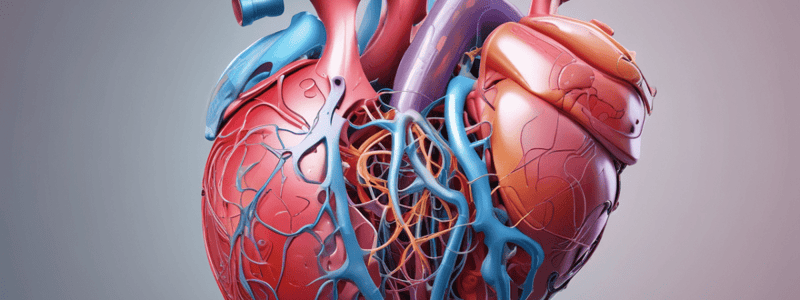Podcast
Questions and Answers
The bottom of the heart is fused to the diaphragm by parts of the ______, which is a serous membrane
The bottom of the heart is fused to the diaphragm by parts of the ______, which is a serous membrane
pericardium
The heart's movements would otherwise create friction with surrounding organs, such as the ______
The heart's movements would otherwise create friction with surrounding organs, such as the ______
lungs
The heart has four chambers, divided into atria and ______
The heart has four chambers, divided into atria and ______
ventricles
The walls of the ventricles are significantly thicker than the walls of the ______
The walls of the ventricles are significantly thicker than the walls of the ______
The atria receive blood from the vessels, and the ventricles pump blood from the ______
The atria receive blood from the vessels, and the ventricles pump blood from the ______
The ______ is the thickest layer of cardiac muscle tissue, found in the middle of the heart wall.
The ______ is the thickest layer of cardiac muscle tissue, found in the middle of the heart wall.
The ______ is the inside lining of the heart, and is an arrangement of simple squamous epithelial tissue.
The ______ is the inside lining of the heart, and is an arrangement of simple squamous epithelial tissue.
The ______ forms the top layer of the heart and is also formed from simple squamous epithelial tissue.
The ______ forms the top layer of the heart and is also formed from simple squamous epithelial tissue.
The ______ valves open when ventricular pressure is greater than arterial pressure and close when the ventricles relax and stop contracting.
The ______ valves open when ventricular pressure is greater than arterial pressure and close when the ventricles relax and stop contracting.
The ______ is a 'sac' that sits around the heart and helps to ensure that the heart stays in position within the mediastinum.
The ______ is a 'sac' that sits around the heart and helps to ensure that the heart stays in position within the mediastinum.
The atrioventricular valves are flops of ______ tissue that separate the atrium and ventricle on each side of the heart.
The atrioventricular valves are flops of ______ tissue that separate the atrium and ventricle on each side of the heart.
The semilunar valves are thicker ______ tissues that separate the ventricles from the arteries.
The semilunar valves are thicker ______ tissues that separate the ventricles from the arteries.
The AV valve on the left side of the heart has two flaps (cusps), so it is referred to as the ______ or mitral valve.
The AV valve on the left side of the heart has two flaps (cusps), so it is referred to as the ______ or mitral valve.
The valve on the right side of the heart is the ______ valve.
The valve on the right side of the heart is the ______ valve.
The heart's movements would otherwise create friction with surrounding organs, such as the ______.
The heart's movements would otherwise create friction with surrounding organs, such as the ______.
The ______ pericardium is the layer that is directly adhered to the heart.
The ______ pericardium is the layer that is directly adhered to the heart.
The ______ pericardium is the layer that is touching the body wall.
The ______ pericardium is the layer that is touching the body wall.
The ______ pericardium helps the heart to stay in place in the mediastinum.
The ______ pericardium helps the heart to stay in place in the mediastinum.
Blood flows from the ______ to the ventricles with the help of gravity.
Blood flows from the ______ to the ventricles with the help of gravity.
The ventricles must pump blood out of the heart and over ______ distances.
The ventricles must pump blood out of the heart and over ______ distances.
Flashcards are hidden until you start studying



